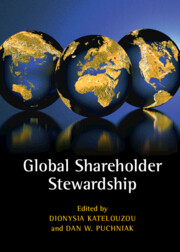68 results
Acknowledgements
-
- Book:
- Global Shareholder Stewardship
- Published online:
- 28 April 2022
- Print publication:
- 12 May 2022, pp xxii-xxiii
-
- Chapter
- Export citation
Tables
-
- Book:
- Global Shareholder Stewardship
- Published online:
- 28 April 2022
- Print publication:
- 12 May 2022, pp xiv-xv
-
- Chapter
- Export citation
Endorsements
-
- Book:
- Global Shareholder Stewardship
- Published online:
- 28 April 2022
- Print publication:
- 12 May 2022, pp i-ii
-
- Chapter
- Export citation
14 - Singapore’s Embrace of Shareholder Stewardship
- from Part II - Jurisdictions
-
-
- Book:
- Global Shareholder Stewardship
- Published online:
- 28 April 2022
- Print publication:
- 12 May 2022, pp 297-315
-
- Chapter
- Export citation
Copyright page
-
- Book:
- Global Shareholder Stewardship
- Published online:
- 28 April 2022
- Print publication:
- 12 May 2022, pp vi-vi
-
- Chapter
- Export citation
Contributors
-
- Book:
- Global Shareholder Stewardship
- Published online:
- 28 April 2022
- Print publication:
- 12 May 2022, pp xvi-xviii
-
- Chapter
- Export citation
1 - Global Shareholder Stewardship
- from Part I - Foundations
-
-
- Book:
- Global Shareholder Stewardship
- Published online:
- 28 April 2022
- Print publication:
- 12 May 2022, pp 3-43
-
- Chapter
-
- You have access
- HTML
- Export citation
Dedication
-
- Book:
- Global Shareholder Stewardship
- Published online:
- 28 April 2022
- Print publication:
- 12 May 2022, pp vii-viii
-
- Chapter
- Export citation
Part II - Jurisdictions
-
- Book:
- Global Shareholder Stewardship
- Published online:
- 28 April 2022
- Print publication:
- 12 May 2022, pp 89-526
-
- Chapter
- Export citation
29 - Shareholder Stewardship in Asia
- from Part III - Comparisons
-
-
- Book:
- Global Shareholder Stewardship
- Published online:
- 28 April 2022
- Print publication:
- 12 May 2022, pp 613-630
-
- Chapter
- Export citation
Index
-
- Book:
- Global Shareholder Stewardship
- Published online:
- 28 April 2022
- Print publication:
- 12 May 2022, pp 663-694
-
- Chapter
- Export citation
18 - Institutional Investors in China
- from Part II - Jurisdictions
-
-
- Book:
- Global Shareholder Stewardship
- Published online:
- 28 April 2022
- Print publication:
- 12 May 2022, pp 379-416
-
- Chapter
- Export citation
28 - Can a Global Legal Misfit Be Fixed?
- from Part III - Comparisons
-
-
- Book:
- Global Shareholder Stewardship
- Published online:
- 28 April 2022
- Print publication:
- 12 May 2022, pp 599-612
-
- Chapter
- Export citation
Abbreviations
-
- Book:
- Global Shareholder Stewardship
- Published online:
- 28 April 2022
- Print publication:
- 12 May 2022, pp xxiv-xxviii
-
- Chapter
- Export citation
Contents
-
- Book:
- Global Shareholder Stewardship
- Published online:
- 28 April 2022
- Print publication:
- 12 May 2022, pp ix-xi
-
- Chapter
- Export citation
Foreword
-
- Book:
- Global Shareholder Stewardship
- Published online:
- 28 April 2022
- Print publication:
- 12 May 2022, pp xix-xxi
-
- Chapter
- Export citation
Part III - Comparisons
-
- Book:
- Global Shareholder Stewardship
- Published online:
- 28 April 2022
- Print publication:
- 12 May 2022, pp 527-662
-
- Chapter
- Export citation
Part I - Foundations
-
- Book:
- Global Shareholder Stewardship
- Published online:
- 28 April 2022
- Print publication:
- 12 May 2022, pp 1-88
-
- Chapter
- Export citation
Figures
-
- Book:
- Global Shareholder Stewardship
- Published online:
- 28 April 2022
- Print publication:
- 12 May 2022, pp xii-xiii
-
- Chapter
- Export citation

Global Shareholder Stewardship
-
- Published online:
- 28 April 2022
- Print publication:
- 12 May 2022



